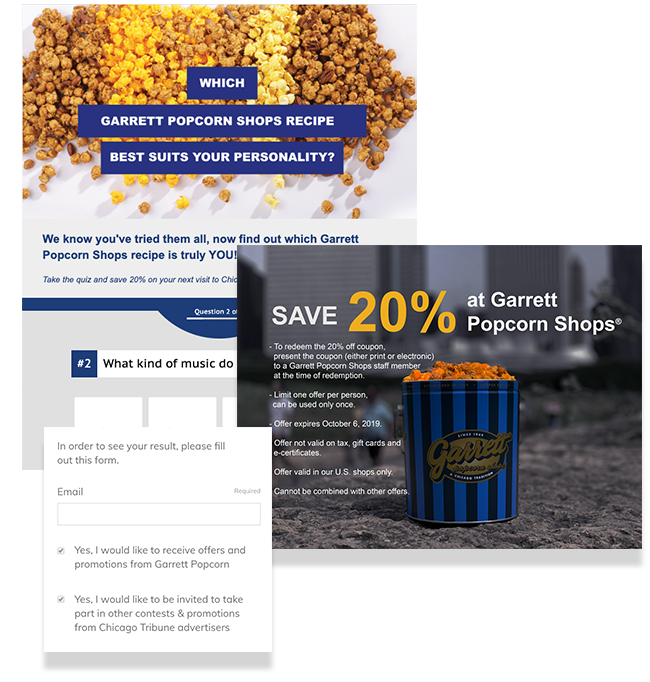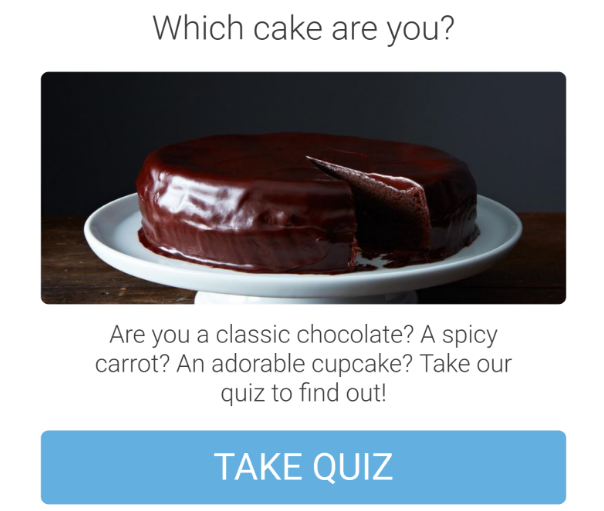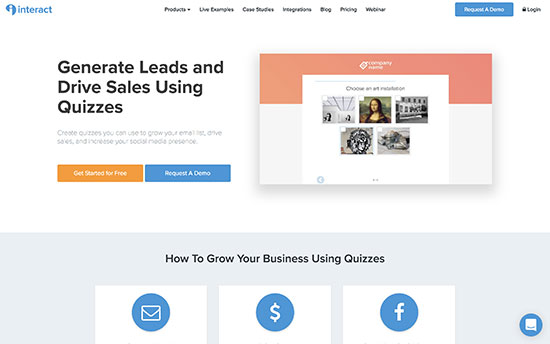Drive up your engagement rate by asking a question that will compel people to comment on your post. You can ask them to share their opinion, personal experiences or stories. Asking a question or giving a call to action at the end of your Instagram caption will give them a reason to comment. Asking a question on your page is another easy way to increase engagement - and it requires few resources (ie. We ask a ton of questions on the Post Planner page, because: we know they get engagement - as shown in the above example; we have a huge arsenal of questions in our Status Ideas Engine; My advice on questions. Let your customers decide. To make things even more interactive, use a poll or quiz to find out what causes your audience wants to support or in what way. Take for example NFL’s campaign against Breast Cancer. The cause is in sharp contrast with the sport, but that makes the campaign all the more compelling. Specific text you’ll use in your post to drive engagement with the announcement, whether questions for your audience, a beneficiary story, or a note of thanks When you have new eyes engaging with your page, that is an opportunity to gain new supporters for your cause if your content is compelling.
In an effort to help out, we’ve compiled some creative strategies for keeping customers engaged and connected during this time.
As you start thinking about how you can best use these, it’s important to remember that while your business stability may be front of mind for you, many people are facing physical, emotional, and financial strain at this time. Communicate with care, consider how you can help your audience feel valued, and be intentional in your approach.

If you have questions, comments, or other topics you want us to talk about, reach out to us on social at @yotpo. Please treat us as a partner, resource, and connection to the broader eCommerce ecosystem as we move through this critical time together.
Customer Engagement Strategies
1. Set-up a hotline
Show your customers that you’re still here for them. Schedule a block of time where customers can chat or DM you questions about products and services.
2. Reward customers for donating
Select a charity helping those affected by the virus, then add an option to donate as a product in your catalog. When customers “purchase” the donation, you can reward them with exclusive loyalty program perks. On the backend, you can treat each donation like a gift card — someone purchases a dollar amount on the site and, instead of creating a credit, you’ll donate those funds to the organization. If your eCommerce platform doesn’t enable this, ask customers to send photos of donation receipts and manually update their loyalty profiles, or give them a discount code.
3. Video chat with customers
Give your customers some face-time. Show them around the store, do live videos of your products, and answer questions in real time. This can help create an in-store feeling and build trust and assurance during what may feel like an isolated time.
4. Create more payment options
As many people face different financial strain or cash flow issues, consider promoting or adding payment tools like Klarna, Afterpay, or Bread Finance to break up payments for consumers.
5. Go virtual

Have an upcoming event that had to be postponed or canceled? Try a virtual webinar or panel. Recreate the networking component by creating a Slack channel or Facebook group for participants or encouraging questions live via social.
6. Spotlight your reviews
Build trust and transparency by refocusing on reviews for those traditional brick & mortar customers that are now shopping online.
7. Increase the value of loyalty program points
Show your customers you’re just as loyal to them as they are to you, especially in this critical time. Increase the value of their loyalty program points or make redemption options cheaper.
8. Go live on Instagram
Go live on Instagram to answer any questions and help customers who may be concerned about the impact of the Coronavirus.
9. Try free shipping and returns
If you’re able, consider trying out free shipping and returns, enabling customers to get a feel for your products from the comfort of their home.
10. Over-communicate!
Your customers are your community. Let them know how you’re responding to the Coronavirus, if anything has changed about how you’re conducting business, and what health precautions you’re taking. Ask them how you can support them during this time, and let them know how they can support your brand as well. Meet them where they are with updates to your homepage, getting active on your social media, and solutions like SMSBump or Klaviyo.
11. Offer gift cards
If you had to close down shop or have customers that shop on an as-needed basis, offer online gift cards for customers to buy now and use later.
12. Ask for help when you need it
Do you have retail locations you’ve had to close indefinitely? Are you struggling to support an in-store staff who is now out of work? Consider asking your customers to chip in by creating a fund for out-of-work employees — giving consumers an opportunity to come together, get involved, and support your business.
13. Try a percentage giveback with purchase
If you’re financially able, consider giving a percentage of each purchase to an organization working to combat COVID-19. This allows consumers to support the brands they love while also supporting those working to alleviate the impact of the Coronavirus.
14. Deliver without compromise
If you have a local consumer base, try offering free, no-contact deliveries or curbside pickups for your customers.
15. Meet customers for 1:1 appointments
If you’re able, offer in-store appointments to give customers the full experience while still respecting guidelines of the CDC, WHO or other state and local health departments.
Yotpo’s commitment to our community
If you have a Customer Success Manager at Yotpo and want help strategizing, please reach out to them. We’d be happy to help brainstorm additional ways to deepen your customer relationships as we navigate these challenging times together.
To find Yotpo’s response to COVID-19, as well as additional strategies and resources, please visit our COVID-19 Resources page.

On July 5, 2014, a food blog called Food52 shared a quiz on Twitter titled, “Which cake are you?”
The quiz was built to raise awareness for several new cake recipes on the site, and the results of the quiz showed each quiz taker’s “cake type,” as well as a link to check out the recipe for said cake on Food52’s blog.
By the end of the day on July 7, just three days later, the quiz had been viewed more than 20,000 times — it was a hit.
Food52’s quiz-success story is not the only recent one. In the last six months, quizzes have been popping up at an increasing pace all over the web.
Content marketers are itching to get involved, but the elements of a successful quiz are complicated.
To help ease the entry into the world of quizzes, I’ve put together guidelines based on more than 1,500 quizzes I’ve helped brands create.
Then, I’m going to outline three top examples of content marketing quizzes, and finally I’ll discuss various distribution methods that drive traffic to your quiz.

Let’s get started.
Part 1: How to create an intriguing quiz
There are several key aspects to keep in mind as you construct your quiz.
Pick the right topic
Before you get started writing a quiz, you’ve got to come up with an idea. For some companies, the answer is obvious, such as “What kind of dog are you?” for a dog blog, but for others the best subject is not so clear. Here are some tips on picking a topic:
- Know your audience. Create your quiz for a specific group of people. Trying to reach the whole world is both impossible and a recipe for failure. If your quiz addresses a group of people that is very interested in the quiz, it will be much more likely to succeed, even if that group is not large.
- Write to one person. Think of one person who would really enjoy your quiz and write to him. This will help you develop a friendly tone and comfortable writing style. Also, if you can’t think of one person who would like your quiz, you may want to rethink the idea.
Write irresistible titles
The title of your quiz is its pickup line. Without a good one, you’ll repel potential quiz takers and fall into the oblivion where bad quizzes go to die. The good news is that there are title templates that consistently perform well and encourage clicks:
- The “actually” title:“How much do you actually know about world cup soccer?” The “actually” title is just a knowledge test, but once you add the word “actually” or “really,” it becomes a challenge, and no one wants to back down from a challenge.
- The “Which (blank) are you?” title:“Which cake are you?” These quizzes are based off of the traditional Meyers-Briggs personality quiz; just replace the personality types with the appropriate results for your quiz topic.
- The celebrity comparison title:“Which celebrity hairstyle should you get?” This template is similar to the personality quiz, but you can place different results into the quiz that relate to your business.
Craft the questions
The questions of a quiz are where you get the chance to create a conversation with quiz takers and build rapport. This is where quizzes really start to show their magic. Unlike many other forms of content, quizzes are a one-to-one medium where you can speak directly to each person who takes your quiz.
Here are a few tips on building that conversation:
- Let your personality shine. Or use an alternate personality and let that shine. The best quizzes create a connection with people by injecting some personality — whether it’s your own or a character you create.
- Follow the pub rule. Ask questions as if you were sitting in a pub with friends. This rule is named after the Irish Post , a UK newspaper that effectively reached Irish people living in London with a clever quiz that had a conversational question style.
- Don’t be afraid to get personal. Encourage people to tell you about themselves through their answers to your quiz questions.
Design results that get shared
The results of your quiz are your chance to get shared, promote products, and get clicks to your website. There are some simple rules to follow to maximize your chances of success:
- Be positive. We prefer to share things that make us look good on social media. Make the results of your quizzes positive to maximize the possibility of people sharing your quiz.
- Don’t lie. While you want to be positive, don’t just blow smoke. Base your positivity on real facts. For example, if you tell someone he is a truck, note how reliable and useful trucks are and avoid mentioning that trucks are big and dirty.
- Prepare to be shared. There is a specific formula for how quizzes get shared. It goes like this: “I got [my result] [title of the quiz].” For example, “I got Chocolate. Which cake are you?” When writing your quiz, make sure your quiz results and quiz title play nicely together when shared.
Part 2: Three ways to use quizzes
A quiz is a fun, interactive piece of digital media that doesn’t feel like traditional marketing.
Here are three examples of ways companies have used quizzes to promote their businesses.
To drive traffic from the social web
Quizzes can bring social traffic back to your domain where your sales funnels can then go to work.
The Food52 quiz I mentioned at the beginning of this post did an excellent job in this arena. Each quiz result included a link to check out a recipe, and the quiz drove thousands of visits back to Food52.com from Facebook and Twitter.
Using Quizzes To Drive Engagement On Your Site Account
To generate new leads
You can use quizzes to collect new email leads by presenting an opt-in just before displaying the results of a quiz.
A good example of using a quiz to generate new leads comes from Worth Global Style Network (WGSN), an analytics company for fashion.
WGSN created a quiz called “What’s Your Customer Type?” and shared it with prospective customers. The quiz content demonstrates the solutions that WGSN provides for their clients. Just before showing the results of the quiz that reveal your customer type, the quiz asked for an email address so that WGSN could send more information about customer analytics.
The same principle can be used with any business — just swap out the call to action and you’re all set.
To gather valuable information about your visitors
Quiz analytics can reveal extremely useful data about your web visitors. By understanding what kind of people are on your site and what their interests are, you can design future content that will help your audience.
A good example of this comes from Zlien, a site that helps contractors get paid. They created a quiz about payments and shared it on their blog. After the quiz had been taken a few hundred times, analytics began to show where readers were struggling, and Zlien used that information to create new articles that educate readers in these areas.
Part 3: How to distribute your quiz
Once you’ve created the perfect quiz for your marketing purposes, you’ll want to promote it so people can take it. Here are four easy ways.
On your website or blog
A quiz can be embedded into any webpage, just like a YouTube video. When a quiz is on your website, all the social shares, links, and comments happen on your domain and you don’t risk losing people to the abyss of social media.
On Facebook
There are two different options for sharing quizzes on Facebook that have distinct advantages:
- On your timeline. Sharing on your Facebook timeline is the easiest option for getting your quiz out there. All you need to do is grab an image (or use one from your quiz) and share it along with a link to take your quiz either on your blog or on a dedicated quiz page.
- In a custom tab. To use a quiz as a more permanent fixture on your Facebook page, you can embed it into a custom tab. My favorite example of this comes from UC Davis. They embedded a quiz “Which Famous Aggie Are You?” onto their new students page so that prospective scholars could feel a connection to the school.
On Twitter
The formula for sharing your quiz on Twitter works the same way as sharing on a Facebook timeline, and it’s helpful if you use an image to visually represent your quiz. Share your quiz on Twitter in the middle of a day on a weekday, then share it two more times in the next three days, and don’t share it again.
In an email newsletter
You can share quizzes through an email newsletter that drive engagement to your website. Provide a link to your quiz that leads to a dedicated page on your site with just your quiz and nothing else.
Over to you …
Food52 attracted an audience of 20,000 in three days using a quiz, and you can do the same for your site.
Using Quizzes To Drive Engagement On Your Site Website
Building popular quizzes is not simple, but once you understand how quizzes can be incorporated into your content marketing, you can use them as a new way to reach and engage your audience.
Have you used quizzes before to market your business?
Which topics interest your readers the most?
Let’s go over to Google+ and continue discussing quiz best practices!

Using Quizzes To Drive Engagement On Your Site Without
Flickr Creative Commons Image via Oberazzi.
